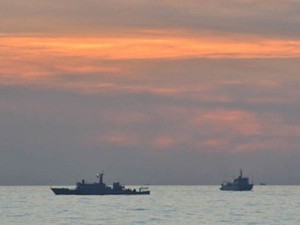Vietnam rejects Chinese protest over island claims

Chinese surveillance ships are seen off Scarborough Shoal in his undated file photo taken by the Philippine Navy and released by the Department of Foreign Affairs. AFP/DFA
HANOI, Vietnam—Vietnam has rejected China’s protest over a new Vietnamese law that reasserts territorial claims over two West Philippine Sea (South China Sea) island groups China and other countries consider their own.
The Chinese accusations that Vietnam’s law was illegal and invalid were groundless, Foreign Ministry spokesman Luong Thanh Nghi said in a statement posted on the ministry’s website late Thursday.
Vietnam’s National Assembly overwhelmingly passed the new maritime law Thursday asserting Vietnam’s sovereignty over the Spratlys and Paracels, and Nghi said this was a “normal lawmaking activity” and Chinese opposition to it was regrettable.
China had summoned the Vietnamese ambassador Thursday to lodge a protest and repeat China’s position that it has sole jurisdiction over the Spratly and Paracel islands.
China claims virtually the entire West Philippine Sea and its island groups, and its dispute with Vietnam and other rival claimants occasionally erupts into open confrontation. The islands, many of them occupied by garrisons from the various claimants, sit amid some of the world’s busiest commercial sea lanes, along with rich fishing grounds and potential oil and gas deposits.
Article continues after this advertisementNghi said Vietnam has legal and historical bases to affirm its sovereignty and that Vietnam’s new law will not affect the process seeking a solution to the disputes.
Article continues after this advertisementVietnam also “strongly protested” a step China’s Hainan province has taken to consolidate its administration over the disputed areas. Chinese officials have said the new entity, Sansha City administration, replaces three separate management offices and is intended to boost development in the Paracels, Spratlys and other areas and better protect Hainan’s marine environment.
Vietnam and China both claim the Paracels. The two countries along with the Philippines, Malaysia, Brunei and Taiwan also claim all or parts of the Spratlys which sit on one of the world’s busiest commercial sea lanes and potential oil and gas reserves.